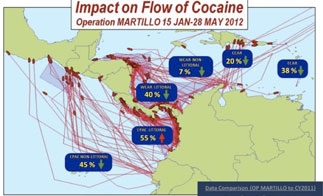The US military’s South Command has released data on the impact of Operation Martillo, intended to cut maritime drug trafficking through Central America, which shows that cocaine flows have decreased in most areas, though they are spiking in the east Caribbean, with many boats leaving Colombia’s Pacific coast.
This map comes from testimony [PDF] given Tuesday in a House Homeland Security Subcommittee hearing by Coast Guard Rear Adm. Charles Michel, who heads the US Southern Command’s Joint Interagency Task Force South (JIATF-S). Based in Key West, Florida, Adm. Michel’s agency monitors all suspicious air and sea traffic headed toward the United States from the Andes and across Central America and the Caribbean.
The map shows the effect that JIATF-S is measuring from “Operation Martillo” (Martillo = Hammer), a “surge” operation to increase surveillance and patrolling in waters near Central America. Operation Martillo began in January, and SouthCom (especially the Navy’s 4th Fleet) and the Coast Guard are coordinating it with several Latin American and European security forces.

The map shows an apparent decrease in cocaine flows in most areas, especially the Caribbean, with one very big exception. In response to Operation Martillo, cocaine trafficking appears to be spiking in the eastern Caribbean, with a dense concentration of boats leaving Colombia’s Pacific coast.
The Colombian Pacific is a flashpoint of the country’s armed conflict right now. Often in cooperation with the FARC guerrillas, paramilitary successor groups, especially the Rastrojos and the Urabeños, are moving many tons of illegal drugs out of port cities like Buenaventura and Tumaco, and using long-neglected Afro-Colombian communities in Choco, Valle, Cauca and Nariño as staging areas. Nariño continues to be Colombia’s number-one coca-producing department. (See our report about Tumaco, Nariño’s main Pacific port, from last year.)
In his written testimony, meanwhile, Adm. Michel estimates that “go-fast” surface boats carried “490 metric tons of cocaine from South America toward the United States.” Approximately another 330 metric tons per year, he added, comes to the United States in semi-submersible craft or crude submarines.
That is a total of 820 tons of cocaine coming to the United States, to which must be added cocaine which comes via aircraft, which according to Michel’s testimony is 20 percent of the total.
From that, we get a JIATF estimate of roughly 1,000 metric tons of cocaine headed each year from South America toward the United States.
(Update as of 4:45 p.m.: There was no need to extrapolate an estimate here. SouthCom Commander Gen. Douglas Fraser’s March 2012 Posture Statement (PDF), on page 6, already provides an estimate of 1,086 tons of cocaine headed toward the United States in 2011, and an expected 775-930 tons in 2012.)
This figure clashes with the estimate from the State Department, which prefers to extrapolate from the amount of coca-leaf cultivation detected and eradicated. The State Department’s latest International Narcotics Control Strategy Report speaks of “700 metric tons of cocaine shipped annually from Colombia and other producing nations intended for the US markets.”
One agency says 700 tons, another says about 1,000 tons. Estimating cocaine trafficking is admittedly a very inexact science, but this is a 43 percent discrepancy.
Republished from Just the Facts with permission from Adam Isacson*. Read original post here.

